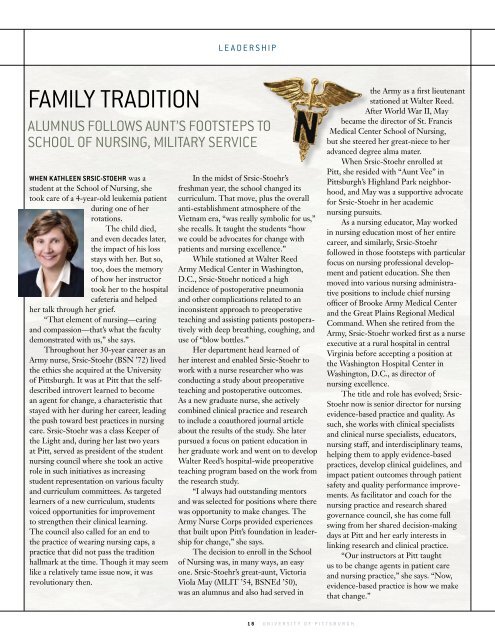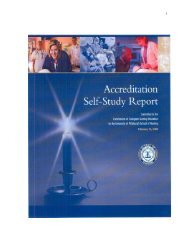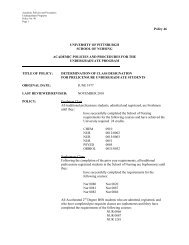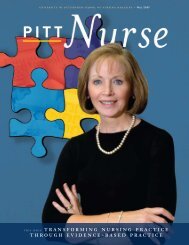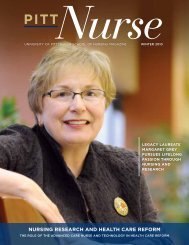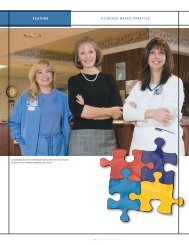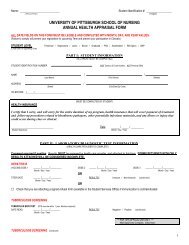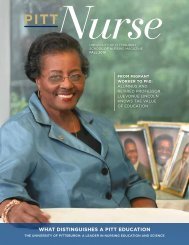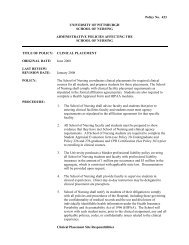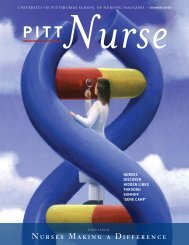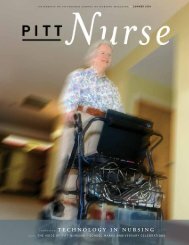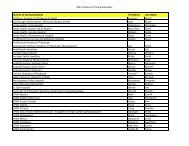primary care nurses, nursing care beyond the ... - School of Nursing
primary care nurses, nursing care beyond the ... - School of Nursing
primary care nurses, nursing care beyond the ... - School of Nursing
- No tags were found...
Create successful ePaper yourself
Turn your PDF publications into a flip-book with our unique Google optimized e-Paper software.
leadershipFamily traditionAlumNus follows aunt’s footsteps to<strong>School</strong> <strong>of</strong> <strong>Nursing</strong>, military serviceWhen Kathleen Srsic-Stoehr was astudent at <strong>the</strong> <strong>School</strong> <strong>of</strong> <strong>Nursing</strong>, shetook <strong>care</strong> <strong>of</strong> a 4-year-old leukemia patientduring one <strong>of</strong> herrotations.The child died,and even decades later,<strong>the</strong> impact <strong>of</strong> his lossstays with her. But so,too, does <strong>the</strong> memory<strong>of</strong> how her instructortook her to <strong>the</strong> hospitalcafeteria and helpedher talk through her grief.“That element <strong>of</strong> <strong>nursing</strong>—caringand compassion—that’s what <strong>the</strong> facultydemonstrated with us,” she says.Throughout her 30-year <strong>care</strong>er as anArmy nurse, Srsic-Stoehr (BSN ’72) lived<strong>the</strong> ethics she acquired at <strong>the</strong> University<strong>of</strong> Pittsburgh. It was at Pitt that <strong>the</strong> selfdescribedintrovert learned to becomean agent for change, a characteristic thatstayed with her during her <strong>care</strong>er, leading<strong>the</strong> push toward best practices in <strong>nursing</strong><strong>care</strong>. Srsic-Stoehr was a class Keeper <strong>of</strong><strong>the</strong> Light and, during her last two yearsat Pitt, served as president <strong>of</strong> <strong>the</strong> student<strong>nursing</strong> council where she took an activerole in such initiatives as increasingstudent representation on various facultyand curriculum committees. As targetedlearners <strong>of</strong> a new curriculum, studentsvoiced opportunities for improvementto streng<strong>the</strong>n <strong>the</strong>ir clinical learning.The council also called for an end to<strong>the</strong> practice <strong>of</strong> wearing <strong>nursing</strong> caps, apractice that did not pass <strong>the</strong> traditionhallmark at <strong>the</strong> time. Though it may seemlike a relatively tame issue now, it wasrevolutionary <strong>the</strong>n.In <strong>the</strong> midst <strong>of</strong> Srsic-Stoehr’sfreshman year, <strong>the</strong> school changed itscurriculum. That move, plus <strong>the</strong> overallanti-establishment atmosphere <strong>of</strong> <strong>the</strong>Vietnam era, “was really symbolic for us,”she recalls. It taught <strong>the</strong> students “howwe could be advocates for change withpatients and <strong>nursing</strong> excellence.”While stationed at Walter ReedArmy Medical Center in Washington,D.C., Srsic-Stoehr noticed a highincidence <strong>of</strong> postoperative pneumoniaand o<strong>the</strong>r complications related to aninconsistent approach to preoperativeteaching and assisting patients postoperativelywith deep breathing, coughing, anduse <strong>of</strong> “blow bottles.”Her department head learned <strong>of</strong>her interest and enabled Srsic-Stoehr towork with a nurse researcher who wasconducting a study about preoperativeteaching and postoperative outcomes.As a new graduate nurse, she activelycombined clinical practice and researchto include a coauthored journal articleabout <strong>the</strong> results <strong>of</strong> <strong>the</strong> study. She laterpursued a focus on patient education inher graduate work and went on to developWalter Reed’s hospital-wide preoperativeteaching program based on <strong>the</strong> work from<strong>the</strong> research study.“I always had outstanding mentorsand was selected for positions where <strong>the</strong>rewas opportunity to make changes. TheArmy Nurse Corps provided experiencesthat built upon Pitt’s foundation in leadershipfor change,” she says.The decision to enroll in <strong>the</strong> <strong>School</strong><strong>of</strong> <strong>Nursing</strong> was, in many ways, an easyone. Srsic-Stoehr’s great-aunt, VictoriaViola May (MLIT ’54, BSNEd ’50),was an alumnus and also had served in<strong>the</strong> Army as a first lieutenantstationed at Walter Reed.After World War II, Maybecame <strong>the</strong> director <strong>of</strong> St. FrancisMedical Center <strong>School</strong> <strong>of</strong> <strong>Nursing</strong>,but she steered her great-niece to heradvanced degree alma mater.When Srsic-Stoehr enrolled atPitt, she resided with “Aunt Vee” inPittsburgh’s Highland Park neighborhood,and May was a supportive advocatefor Srsic-Stoehr in her academic<strong>nursing</strong> pursuits.As a <strong>nursing</strong> educator, May workedin <strong>nursing</strong> education most <strong>of</strong> her entire<strong>care</strong>er, and similarly, Srsic-Stoehrfollowed in those footsteps with particularfocus on <strong>nursing</strong> pr<strong>of</strong>essional developmentand patient education. She <strong>the</strong>nmoved into various <strong>nursing</strong> administrativepositions to include chief <strong>nursing</strong><strong>of</strong>ficer <strong>of</strong> Brooke Army Medical Centerand <strong>the</strong> Great Plains Regional MedicalCommand. When she retired from <strong>the</strong>Army, Srsic-Stoehr worked first as a nurseexecutive at a rural hospital in centralVirginia before accepting a position at<strong>the</strong> Washington Hospital Center inWashington, D.C., as director <strong>of</strong><strong>nursing</strong> excellence.The title and role has evolved; Srsic-Stoehr now is senior director for <strong>nursing</strong>evidence-based practice and quality. Assuch, she works with clinical specialistsand clinical nurse specialists, educators,<strong>nursing</strong> staff, and interdisciplinary teams,helping <strong>the</strong>m to apply evidence-basedpractices, develop clinical guidelines, andimpact patient outcomes through patientsafety and quality performance improvements.As facilitator and coach for <strong>the</strong><strong>nursing</strong> practice and research sharedgovernance council, she has come fullswing from her shared decision-makingdays at Pitt and her early interests inlinking research and clinical practice.“Our instructors at Pitt taughtus to be change agents in patient <strong>care</strong>and <strong>nursing</strong> practice,” she says. “Now,evidence-based practice is how we makethat change.”18 university <strong>of</strong> Pittsburgh


